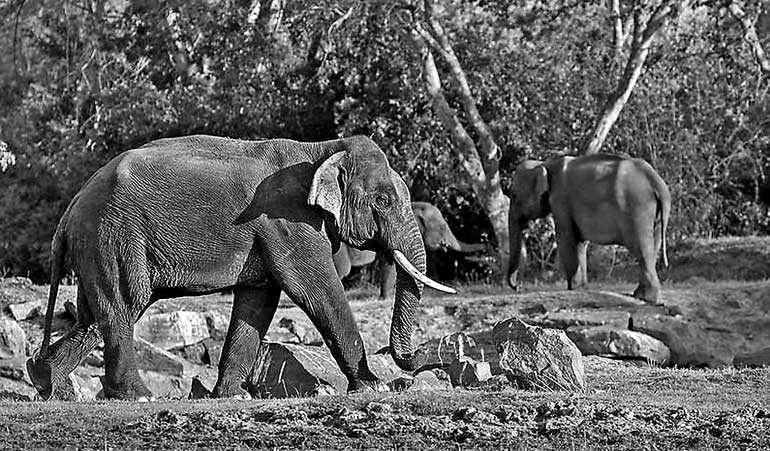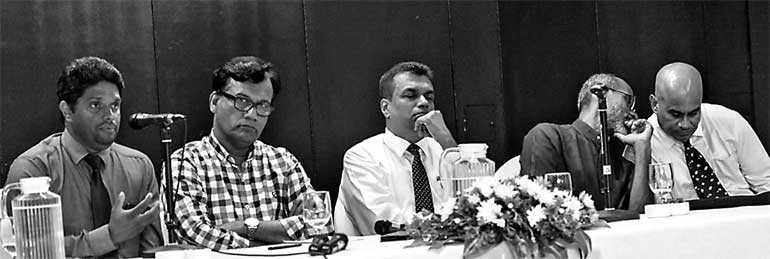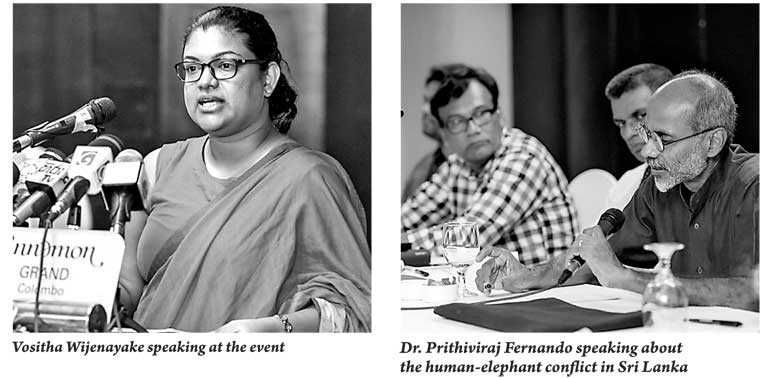Wednesday Mar 05, 2025
Wednesday Mar 05, 2025
Saturday, 26 October 2019 00:11 - - {{hitsCtrl.values.hits}}

A meandering colossus – Pic by Danushka Senadheera
By Nadeesha Paulis
Humane Society International, together with the SLYCAN Trust, organised a lecture on ‘Addressing the human-elephant conflict in Sri Lanka’ followed by a panel discussion on 14 October.
Dr. Prithiviraj Fernando, an expert in the field of conservation with over 25 years’ experience, spoke on the present situation in the country.
At present, Sri Lanka is home to about 7,000-8,000 wild elephants roaming over close to 70% of the country’s land compared with countries such as India where elephants only occupy 3%. Despite this blessing, around 150 elephants and 50 people die each year as a result of the human-elephant conflict (HEC). The main reasons for the altercations between humans and elephants are the drastic increase in the human population, human encroachment upon elephant territory for agriculture and settlements and unplanned development efforts. This is why the HEC is neither simple nor straightforward. It is not a problem with easy solutions.
In an effort to manage the HEC, the Wildlife Conservation Department has tried several methods, namely elephant translocation, setting up an elephant holding ground in Horowpathana, mass elephant drives and the installation of electric fences.
Dr. Fernando revealed that there were close to 25 cases, including those of ‘Chandi’ and ‘Brigadier’, of lone male elephants being translocated to more favourable locations because of their “troublesome” nature. Unfortunately, the elephants in almost all 25 cases had returned to their home range, sometimes crossing over 200 km, making the translocation of elephants detrimental to both humans and elephants. “It’s like Jurassic Park. They don’t like to call it a prison but that’s what it is,” said Dr. Fernando, speaking about the elephant holding ground from which elephants would always break free, even though it was as secure as a fortress.

From left: Dr. Ajith Gunewardena, Hemantha Withanage, Anura Sathurusinghe, Dr. Pruthuviraj Fernando and Rohan Wijensinha
Elephant drives are another tactic to relocate many elephants to existing parks, sometimes 100-200 elephants at a time, but again the problem is unresolved because 95% of them consist of innocent females and their juveniles which means that the problem-causing elephants are left behind. Using ali wedi or huge firecrackers to scare the elephants away is also futile because while it may scare away the females, who do not cause harm in the first place, it will only aggravate and annoy the male elephants who, as a result, inflict more damage.
The panel of speakers at the event consisted of Rohan Wijensinha - Chairperson of the Federation of Environmental Organisations; Dr. Ajith Gunewardena - Assistant Director of the Central Environment Authority, Hemantha Withanage - Executive Director at the Center for Environmental Justice; Anura Sathurusinghe - Director of the Ecosystems and Conservation Programme at SLYCAN Trust and Dr. Pruthuviraj Fernando - Chairman of the Center for Conservation and Research. The panel discussion was moderated by Vositha Wijenakaye of Humane Society International of Sri Lanka.
“The income generated from the Minneriya and Kaudulla National Parks during the season adds about Rs. 1.75 billion to the local economy. That’s how valuable elephants (and other wildlife) are to us,” said Wijensinha, who emphasised the need for planned development in these areas to enable human-elephant co-existence.
“The policies are not enough. Sri Lanka needs movements that go beyond policies,” added Wijensinha, encouraging the youngsters present at the event to initiate a wave of change.
Sathurusinghe spoke about deforestation and how it impacted the HEC.
“At the moment, large-scale infrastructure developments such as roads and reservoirs contribute to deforestation more than encroachments,” said Sathurusinghe.
He explained that on average, 7,500-8,000 hectares of land was undergoing deforestation in Sri Lanka, which is a low rate compared with other countries but still a cause for concern, and emphasised the need to identify a value for the ecosystems similar to India’s tiger reserves so that all stakeholders involved, from policymakers to inhabitants, were aware of the need for conservation.

Withanage identified ‘hakka patas’ as a big threat to elephants. Attached to a pumpkin or pineapple, this device detonates once an animal bites it, badly wounding and ultimately killing it. He also spoke of unplanned development projects such as roads and housing schemes that are built within elephant corridors and adversely affect the elephants who have been using these corridors for generations to migrate.
“This is a man-made, politically-fueled conflict,” said Withanage, who called out for science-backed elephant management policies that would help both man and animal.
Speaking on elephant corridor mapping and habitat management through remote and satellite-based technology, Dr. Ajith Gunewardena said: “We’ve initiated a project to map out the ecosystem services in Kamberawa in the Knuckles range where we use high-res satellite data to identify habitat quality, pollination, the sediment delivery ratio, land degradation, environmental sensitivity and so on.”
He also spoke on using technology and methods such as strategic environmental assistance to identify which areas needed to be conserved and which areas were suitable for human settlements and development projects.
Speaking at the event, Vositha Wijenayake stated: “Humane Society International and the SLYCAN Trust will continue work to address the human elephant conflict in Sri Lanka. Addressing HEC is a timely need and our activities will focus on capacity building, research, stakeholder engagement and policy advocacy. We look forward to the engagement of other stakeholders in the process.”

Lecture on the human-elephant conflict in Sri Lanka
Discover Kapruka, the leading online shopping platform in Sri Lanka, where you can conveniently send Gifts and Flowers to your loved ones for any event including Valentine ’s Day. Explore a wide range of popular Shopping Categories on Kapruka, including Toys, Groceries, Electronics, Birthday Cakes, Fruits, Chocolates, Flower Bouquets, Clothing, Watches, Lingerie, Gift Sets and Jewellery. Also if you’re interested in selling with Kapruka, Partner Central by Kapruka is the best solution to start with. Moreover, through Kapruka Global Shop, you can also enjoy the convenience of purchasing products from renowned platforms like Amazon and eBay and have them delivered to Sri Lanka.
Discover Kapruka, the leading online shopping platform in Sri Lanka, where you can conveniently send Gifts and Flowers to your loved ones for any event including Valentine ’s Day. Explore a wide range of popular Shopping Categories on Kapruka, including Toys, Groceries, Electronics, Birthday Cakes, Fruits, Chocolates, Flower Bouquets, Clothing, Watches, Lingerie, Gift Sets and Jewellery. Also if you’re interested in selling with Kapruka, Partner Central by Kapruka is the best solution to start with. Moreover, through Kapruka Global Shop, you can also enjoy the convenience of purchasing products from renowned platforms like Amazon and eBay and have them delivered to Sri Lanka.